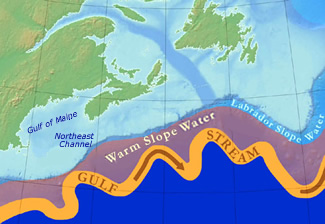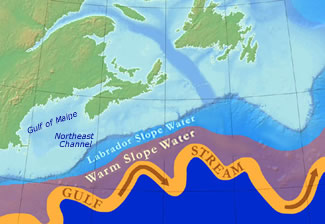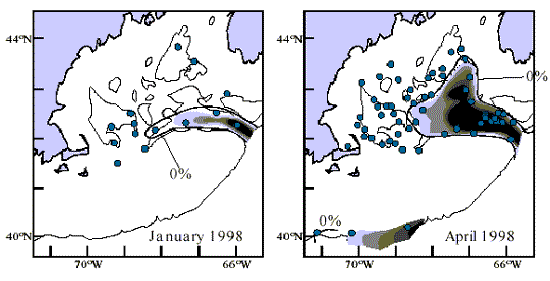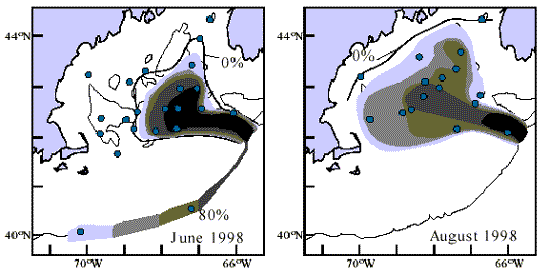Environmental Prediction in the Gulf of Maine
Forecast of North Atlantic right whale births
Using NAO to forecast temperature of water entering Gulf of Maine

40-year graph 10-year graph
Andrew Pershing of Cornell University and his collaborators developed a mathematical model that predicts the temperature of deep water entering the Gulf of Maine through the Northeast Channel. This water is called slope water because it comes from the continental slope. The prediction is calculated based on the previous year's NAO index and slope water temperature. The latest forecast is shown on the graph above. This temperature forecast can be plugged into subsequent models (see 3. Plankton and 4. Whale calves) to forecast the right whale's food supply and birth rate. However, because GoMOOS Buoy N, located in the Northeast Channel, provides direct measurements, not predictions, of slope water temperature, using the Buoy N data in the step 3. Plankton (food supply) and step 4. Whale calves (birth rate) models enables more accurate forecasts.
Sign up to get new forecasts by email.
NAO alters flow of warm or cold water from the continental slope into Gulf of Maine
The North Atlantic Oscillation (NAO) affects the strength and direction of winds blowing across the North Atlantic Ocean. In turn, the winds alter the circulation of water in the ocean. The effects on the Gulf of Maine are significant. In particular, the NAO helps determine the characteristics of water flowing at depths of 150 meters into the Gulf of Maine from the continental slope through the Northeast Channel. The Northeast Channel separates Georges Bank and Nova Scotia. Like an umbilical cord, it is a major connector between the Gulf of Maine and the North Atlantic Ocean. Either of two distinct, deep water masses—one cold, one relatively warm—may predominate outside the Gulf of Maine along the continental slope. Approximately one year after the NAO index becomes positive, Warm Slope Water penetrates the Northeast Channel into the Gulf. Conversely, one year after the NAO index becomes negative, Labrador (cold) Slope Water enters through the Northeast Channel. Because the Warm Slope Water and Labrador Slope Water differ in their temperature and the nutrients that they carry, the Gulf of Maine ecosystem is affected tremendously by the shift between these two masses of water from the continental slope. One result is variation in the abundance of the right whale's primary food, Calanus copepods (see 3. Plankton ).

Positive NAO index: Warm Slope Water enters the Gulf of Maine through the Northeast Channel.

A lag can occur before the NAO's oceanographic shifts show up in the Gulf of Maine. In January 1998, for example, Labrador Slope Water (dark gray area in maps below) began to enter the Northeast Channel into the Gulf of Maine at depths of 100 to 300 meters. In April, June, and August, the "tongue" of Labrador Slope Water spread through the Gulf of Maine. This event lagged a negative NAO index by two years.


Blue dots on the maps indicate locations of water samples collected from ships in 1998. Now GoMOOS buoys can provide similar data on a routine basis, enabling ongoing monitoring of deep water entering the Gulf of Maine.


